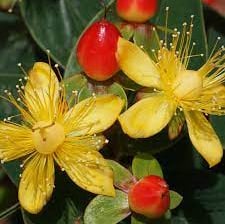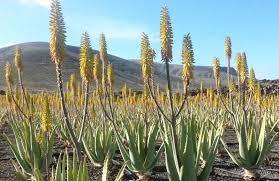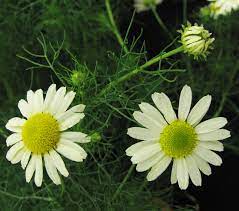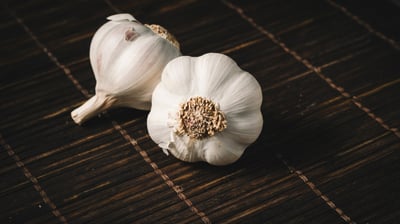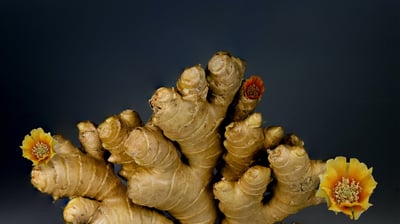Plants with medicinal properties
Please note that while these plants have medicinal properties, it's important to exercise caution and consult with a healthcare professional before using them, especially if you have underlying health conditions or are taking other medications. Proper identification and preparation are also crucial when using wild plants for medicinal purposes.
St. John's Wort (Hypericum perforatum)
St. John's Wort is used to alleviate symptoms of mild to moderate depression and anxiety.
Aloe Vera (Aloe barbadensis miller)
Chamomile (Matricaria chamomilla)
Peppermint (Mentha × piperita)
Dandelion (Taraxacum officinale)


Nettle (Urtica dioica)
Nettle leaves are rich in vitamins and minerals and are used to alleviate allergies, arthritis, and urinary tract issues.
Calendula (Calendula officinalis)
Calendula flowers are used topically in creams and salves to soothe skin irritations, rashes, and minor wounds.
Lavender (Lavandula spp.)
Lavender flowers are known for their calming and soothing properties. Lavender essential oil is used in aromatherapy to reduce stress and promote relaxation. It can also be used topically for minor burns and insect bites.






Turmeric (Curcuma longa)
While not typically found in the wild in most regions, turmeric is a highly valued medicinal plant. It contains the active compound curcumin, which has anti-inflammatory and antioxidant properties. Turmeric is used to relieve joint pain, reduce inflammation, and support overall health.
Use Caution
Again, it's essential to use caution and consult with a healthcare professional when using wild or medicinal plants, and ensure proper identification and preparation.
Unlocking the Health Benefits of Echinacea (Echinacea spp.)
Echinacea, renowned for its immune-boosting capabilities, offers a host of health benefits. From warding off colds to supporting overall well-being, this powerful herb has been utilized for centuries in traditional medicine. Below, we'll delve into the health benefits of Echinacea and explore how to prepare it for optimal use.
Health Benefits:
Immune System Support: Echinacea is best known for its immune-enhancing properties. It stimulates the production and activity of immune cells like white blood cells, thereby helping the body fend off infections. Regular Echinacea supplementation or tea consumption may reduce the severity and duration of colds and respiratory infections.
Anti-Inflammatory Effects: This herb possesses anti-inflammatory properties, making it beneficial for conditions characterized by inflammation, such as arthritis and skin disorders. It can help alleviate symptoms and improve overall comfort.
Antioxidant Protection: Echinacea is rich in antioxidants, which combat free radicals in the body. These free radicals can cause oxidative stress and damage to cells, potentially leading to chronic diseases. The antioxidants in Echinacea may help mitigate this damage.
Enhanced Respiratory Health: Beyond its immune-boosting attributes, Echinacea can alleviate symptoms of respiratory conditions like bronchitis and sinusitis. It may help reduce congestion, soothe irritated airways, and promote quicker recovery.
Wound Healing: Some studies suggest that Echinacea's topical application can aid in wound healing. It may help reduce inflammation, prevent infection, and expedite the body's naturEchinacea (Echinacea spp.): Harnessing the Power of Immune Support
Echinacea, a genus of flowering plants native to North America, is celebrated for its remarkable immune-boosting properties. It's often used to prevent and treat colds and respiratory infections. Let's explore the health benefits and how to use Echinacea.
Health Benefits:
Immune System Boost: Echinacea is best known for its immune-enhancing properties. It contains compounds like flavonoids, alkamides, and polysaccharides that stimulate immune cell activity. This helps the body fend off infections more effectively and can reduce the severity and duration of illnesses like colds and respiratory infections.
Cold and Respiratory Support: Echinacea is widely used to prevent and alleviate the symptoms of the common cold, flu, and other respiratory infections. It can help reduce congestion, sore throat, and overall discomfort associated with these ailments.
Anti-Inflammatory and Antioxidant Effects: Echinacea also exhibits anti-inflammatory and antioxidant properties, which can have broader health benefits. It may help reduce inflammation and protect cells from oxidative stress.
Wound Healing: Some studies suggest that Echinacea's topical application can aid in wound healing. It may help reduce inflammation, prevent infection, and expedite the body's natural healing processes.
How to Prepare Echinacea:
Echinacea Tea:
Use dried Echinacea root, leaves, or flowers, which are readily available in health food stores.
Boil water and pour it over the Echinacea herb in a teapot or cup.
Allow it to steep for about 5-10 minutes.
Strain and sweeten with honey or a slice of lemon if desired.
Echinacea Tinctures:
Echinacea tinctures are concentrated liquid extracts available in health food stores or online.
Follow the recommended dosage instructions on the product label. Tincture strengths may vary.
Echinacea Capsules or Tablets:
Echinacea is available in the form of capsules or tablets for convenient consumption.
Consult a healthcare provider or follow the recommended dosage instructions on the product label.
Echinacea Topical Applications:
Echinacea creams or ointments can be applied directly to wounds or irritated skin.
Follow the instructions on the product label for proper use.
Important Considerations:
Consult with a healthcare professional before incorporating Echinacea into your health regimen, especially if you have allergies, underlying health conditions, or are taking medications.
It's essential to adhere to recommended dosages, as overuse or misuse can lead to potential side effects, such as digestive upset or allergic reactions.
Echinacea is a versatile and valuable herb with a strong focus on immune system support. Whether you prefer Echinacea tea, tinctures, capsules, or topical applications, its immune-boosting potential can be a valuable addition to your holistic health toolkit. Always ensure responsible and informed use to maximize its benefits while minimizing potential risks and healing processes.
How to Prepare Echinacea:
Echinacea Tea: Making Echinacea tea is a popular and easy way to enjoy its benefits.
Use dried Echinacea root, leaves, or flowers. You can find Echinacea tea bags or loose dried herbs at health food stores.
Boil water and pour it over the Echinacea herb in a teapot or cup.
Allow it to steep for about 5-10 minutes.
Strain and sweeten with honey or a slice of lemon if desired.
Echinacea Tinctures: Echinacea tinctures are concentrated liquid extracts that can be taken orally.
Purchase a high-quality Echinacea tincture from a reputable source.
Follow the recommended dosage instructions on the product label, as tincture strengths may vary.
Echinacea Capsules or Tablets: If you prefer a convenient option, Echinacea is available in the form of capsules or tablets.
Consult a healthcare provider or follow the recommended dosage instructions on the product label.
Echinacea Topical Applications: For wound healing or skin issues, Echinacea creams or ointments can be applied directly to the affected area.
Follow the instructions on the product label for proper use.
Note:
When using Echinacea supplements, it's essential to adhere to recommended dosages, as excessive consumption may lead to adverse effects.
Consult a healthcare professional before incorporating Echinacea into your health regimen, especially if you have allergies, underlying health conditions, or are taking medications.
Incorporating Echinacea into your health routine may provide valuable support for your immune system and overall well-being. Whether sipping on a soothing cup of Echinacea tea or using it as a natural remedy, this versatile herb can be a valuable addition to your holistic health toolkit.
St. John's Wort (Hypericum perforatum): A Natural Approach to Mood and Well-Being
St. John's Wort, scientifically known as Hypericum perforatum, is a herbal remedy renowned for its potential to alleviate symptoms of mild to moderate depression and anxiety. Let's delve into the health benefits and how to use St. John's Wort.
Health Benefits:
Mood Elevation: St. John's Wort is primarily recognized for its mood-enhancing properties. It contains compounds like hypericin and hyperforin, which may help regulate neurotransmitters like serotonin in the brain. This regulation can contribute to a more stable and positive mood, making it a natural option for those dealing with mild to moderate depression and anxiety.
Anxiety Reduction: The calming effects of St. John's Wort extend to anxiety relief. It can help reduce feelings of restlessness and nervousness, promoting relaxation and mental well-being.
Improved Sleep Patterns: Some individuals find that St. John's Wort can help improve sleep quality, especially if sleep disturbances are linked to mood issues. It can make it easier to fall asleep and stay asleep.
Anti-Inflammatory Properties: St. John's Wort possesses anti-inflammatory properties that can be beneficial for overall health. Reducing inflammation can have a positive impact on various bodily systems.
Where to Find St. John's Wort:
St. John's Wort is native to Europe, but it has naturalized in various regions around the world. You can often find it in the wild in the following places:
Open fields, meadows, and grassy areas.
Roadsides and disturbed habitats.
Sunny, well-drained locations with moderate rainfall.
Before harvesting wild St. John's Wort, it's important to ensure that you're following local regulations and that you have proper identification of the plant. Additionally, consider growing your own St. John's Wort plant, as cultivating it can be a sustainable way to access its benefits.
How to Prepare St. John's Wort:
St. John's Wort Tea:
Harvest fresh St. John's Wort flowers and leaves, or use dried ones.
Add about 1-2 teaspoons of dried herb (or 2-4 teaspoons of fresh herb) to a cup of boiling water.
Allow it to steep for 5-10 minutes.
Strain and enjoy. You can sweeten it with honey if desired.
St. John's Wort Capsules or Tablets:
Commercially available capsules or tablets containing St. John's Wort extract are a convenient option.
Follow the recommended dosage instructions on the product label. Dosages can vary, so consult a healthcare provider for guidance.
Important Considerations:
Always consult with a healthcare professional before using St. John's Wort, especially if you are taking other medications, as it can interact with certain drugs.
It should not be used as a substitute for prescribed medications for severe depression or anxiety. It is best suited for mild to moderate cases and should be used under the guidance of a healthcare provider.
St. John's Wort offers a natural approach to mood enhancement and overall mental well-being. Whether you opt for St. John's Wort tea or supplements, it's essential to use it responsibly and seek professional advice when necessary to ensure that it is safe and appropriate for your individual health needs.
Discovering the Health Benefits, Wild Origins, and Preparation of Aloe Vera
Aloe vera, often referred to as the "wonder plant," is renowned for its numerous health benefits and natural healing properties. With its succulent, spiky leaves, aloe vera is a common sight in many households, and it can also be found in the wild. Let's explore the health benefits of aloe vera, where to find it in the wild, and how to prepare it for various uses.
Health Benefits:
Skin Health: Aloe vera is perhaps best known for its soothing and healing effects on the skin. It is widely used to treat sunburn, minor burns, cuts, and skin irritations. Its gel contains compounds that have anti-inflammatory and moisturizing properties, promoting rapid skin repair.
Hair Care: Aloe vera gel is a popular ingredient in hair care products due to its ability to nourish the scalp and strengthen hair. It can help reduce dandruff, alleviate an itchy scalp, and promote healthy hair growth.
Digestive Aid: Aloe vera juice, derived from the inner leaf gel, is consumed for its potential digestive benefits. It may help soothe digestive discomfort, alleviate constipation, and support a healthy gut.
Oral Health: Aloe vera's natural antibacterial and anti-inflammatory properties make it a useful ingredient in natural toothpaste and mouthwash. It can help combat gum disease, soothe mouth ulcers, and promote oral hygiene.
Antioxidant and Immune Support: Aloe vera is rich in antioxidants, which can help protect the body from oxidative stress and boost the immune system. It may contribute to overall health and well-being.
Where to Find Aloe Vera in the Wild:
Aloe vera is native to arid regions of North Africa and the Arabian Peninsula but has been cultivated and naturalized in many parts of the world. In the wild, you can find aloe vera in:
Desert regions with dry, sandy soil, where it thrives in warm and sunny conditions.
Coastal areas with well-draining soil, as aloe vera can tolerate salt spray.
Keep in mind that if you plan to harvest wild aloe vera, always do so responsibly and with permission if the plant is on private property. Sustainable harvesting practices are essential to protect wild populations.
How to Prepare Aloe Vera:
Aloe Vera Gel for Skin:
Cut a leaf from the aloe vera plant close to its base.
Slice the leaf open lengthwise.
Scoop out the clear gel with a spoon.
Apply the gel directly to the affected skin area.
Aloe Vera Juice:
Extract the gel as mentioned above.
Blend the gel with water or a natural fruit juice to make aloe vera juice.
Consume it in moderation, following recommended guidelines, as excessive consumption can have a laxative effect.
Aloe Vera for Hair:
Mix aloe vera gel with your regular shampoo or conditioner or use it as a leave-in conditioner.
Massage it into your scalp and hair, then rinse thoroughly.
Oral Care:
Use toothpaste or mouthwash containing aloe vera or mix a small amount of aloe vera gel with water and use it as a mouthwash.
Aloe vera is a versatile and valuable plant with a multitude of health benefits. Whether you're addressing skin issues, digestive discomfort, or seeking natural remedies for your hair or oral hygiene, aloe vera can be a beneficial addition to your wellness routine. However, be cautious with its use, especially if you have allergies or experience any adverse reactions.
Chamomile (Matricaria chamomilla): The Soothing Herb for Relaxation and Wellness
Chamomile, scientifically known as Matricaria chamomilla, is a popular herbal remedy celebrated for its calming properties and myriad health benefits. This gentle herb has a long history of use for promoting relaxation and overall well-being. Let's explore the health benefits and ways to prepare chamomile for consumption.
Health Benefits:
Relaxation and Sleep Aid: Chamomile is renowned for its ability to promote relaxation and improve sleep quality. It contains compounds like apigenin that have mild sedative effects, making it a natural remedy for insomnia and restlessness.
Digestive Health: Chamomile is known to soothe the digestive tract, alleviate symptoms of indigestion, and relieve gas and bloating. It can be particularly helpful after a heavy meal.
Anti-Inflammatory and Antioxidant Properties: Chamomile possesses anti-inflammatory and antioxidant properties that may help reduce inflammation, protect cells from oxidative stress, and support overall health.
Skin Health: Chamomile's anti-inflammatory and healing properties make it useful for various skin conditions. It can be applied topically to soothe skin irritations, eczema, and minor wounds.
Menstrual Pain Relief: For some women, chamomile tea may help alleviate menstrual cramps and discomfort due to its muscle-relaxing effects.
How to Prepare Chamomile:
Chamomile Tea:
Place dried chamomile flowers (available in tea bags or loose form) in a cup or teapot.
Boil water and pour it over the chamomile.
Allow it to steep for about 5 minutes.
Strain and sweeten with honey or a slice of lemon if desired.
Chamomile Essential Oil:
Chamomile essential oil can be used in aromatherapy or diluted with a carrier oil for topical application.
It's often used for relaxation, stress relief, and as a natural remedy for skin conditions.
Chamomile Supplements:
Chamomile supplements in the form of capsules or tablets are available in health food stores.
Follow the recommended dosage instructions on the product label.
Important Considerations:
Chamomile is generally safe for most people when consumed in moderation. However, if you have allergies to plants in the Asteraceae family (such as ragweed, marigolds, or daisies), you may be at risk of chamomile allergy.
Pregnant or nursing individuals and those taking certain medications should consult a healthcare professional before using chamomile supplements or consuming it in large quantities.
Chamomile stands as a gentle yet potent herbal remedy for relaxation and overall wellness. Whether you prefer it as a soothing tea, an essential oil for aromatherapy, or a topical treatment for skin issues, chamomile offers a host of natural benefits for both physical and mental health. As with any herbal remedy, it's wise to use chamomile responsibly and seek professional advice if needed to ensure it aligns with your specific health needs.
Peppermint (Mentha × piperita): The Invigorating Herb for Health and Refreshment
Peppermint, scientifically known as Mentha × piperita, is a versatile herb celebrated for its invigorating aroma, cooling flavor, and numerous health benefits. Whether sipped as tea, applied topically, or used in culinary creations, peppermint offers a range of advantages for overall well-being. Let's explore the health benefits and ways to enjoy peppermint.
Health Benefits:
Digestive Aid: Peppermint is known for its ability to soothe digestive discomfort. It can help alleviate symptoms of indigestion, gas, bloating, and irritable bowel syndrome (IBS). Drinking peppermint tea after a meal is a popular tradition for promoting digestive health.
Mental Alertness and Stress Reduction: The invigorating scent of peppermint can promote mental alertness and focus. It may help reduce stress and ease tension when used in aromatherapy or as a refreshing beverage.
Headache Relief: Peppermint oil applied topically or inhaled as a steam can help relieve tension headaches and migraines. Its cooling properties can provide quick relief and relaxation.
Respiratory Health: Peppermint's menthol content can help open airways and ease breathing. It's commonly used as a natural remedy for congestion, sinusitis, and cold symptoms.
Antioxidant Properties: Peppermint contains antioxidants that help combat free radicals and protect cells from oxidative damage. This can contribute to overall health and well-being.
How to Enjoy Peppermint:
Peppermint Tea:
Use fresh peppermint leaves or dried leaves (available in tea bags or loose form).
Boil water and pour it over the peppermint leaves in a cup or teapot.
Allow it to steep for about 5 minutes.
Strain and enjoy. It can be sweetened with honey or lemon if desired.
Peppermint Oil:
Peppermint essential oil can be used in aromatherapy by diffusing it or adding a few drops to a bowl of hot water for steam inhalation.
Diluted peppermint oil can be applied topically for headache relief or mixed with a carrier oil for massage.
Peppermint in Cooking:
Fresh peppermint leaves or dried peppermint can be used as a culinary herb in a variety of dishes, such as salads, desserts, and beverages.
Peppermint Supplements:
Peppermint supplements in the form of capsules or tablets are available in health food stores.
Follow the recommended dosage instructions on the product label.
Important Considerations:
Peppermint is generally safe for most people when consumed in moderation. However, if you have gastroesophageal reflux disease (GERD), a sensitive stomach, or are pregnant or nursing, it's best to consult a healthcare professional before using peppermint supplements or consuming it in large quantities.
Peppermint's refreshing flavor and array of health benefits make it a beloved herb for culinary and wellness purposes. Whether you're sipping on a revitalizing cup of peppermint tea, using peppermint oil for aromatherapy, or incorporating it into your meals, this versatile herb can bring a burst of invigoration and contribute to your overall health and vitality.
Garlic (Allium sativum): The Flavorful Bulb with Remarkable Health Benefits
Garlic, scientifically known as Allium sativum, is a culinary staple celebrated for its unique flavor and a wide range of health benefits. From its robust taste in various dishes to its medicinal properties, garlic has been valued for centuries. Let's delve into the health benefits and ways to incorporate garlic into your diet.
Health Benefits:
Cardiovascular Health: Garlic is known for its potential to support heart health. It can help lower blood pressure, reduce cholesterol levels, and improve circulation, reducing the risk of cardiovascular diseases such as heart attacks and strokes.
Antioxidant Properties: Garlic contains antioxidants that combat free radicals in the body. These antioxidants can help protect cells from oxidative damage, potentially lowering the risk of chronic diseases and supporting overall well-being.
Immune System Boost: Garlic has immune-boosting properties due to its antimicrobial and antibacterial compounds. Regular consumption of garlic may help the body fend off infections and reduce the severity of colds and flu.
Anti-Inflammatory Effects: Garlic's anti-inflammatory properties may help reduce inflammation and alleviate symptoms of inflammatory conditions like osteoarthritis.
Digestive Health: Garlic can aid in digestion by promoting the production of digestive enzymes. It may also help soothe the digestive tract and reduce gastrointestinal discomfort.
How to Incorporate Garlic:
Cooking with Garlic:
Garlic adds depth of flavor to a wide range of dishes, including soups, sauces, stir-fries, and roasts. Crush, mince, or chop fresh garlic cloves and sauté them for a rich, aromatic base to your recipes.
Garlic Supplements:
Garlic supplements, such as garlic capsules or garlic oil, are available for those who prefer a more convenient option.
Follow the recommended dosage instructions on the product label, as dosages can vary.
Raw Garlic:
Consuming raw garlic is another option. Crush or mince a clove and mix it with honey, olive oil, or yogurt for a powerful and pungent health tonic.
Important Considerations:
While garlic offers numerous health benefits, its strong flavor and odor may not be suitable for everyone. Some individuals may experience digestive discomfort or heartburn after consuming large amounts of raw garlic.
Garlic supplements may interact with certain medications, so consult with a healthcare professional if you have concerns about potential drug interactions.
Garlic's flavorful presence in cuisines around the world is matched by its reputation as a natural remedy for various health conditions. Whether you're using it as a culinary ingredient, taking it as a supplement, or incorporating it into your daily routine, garlic is a versatile and valuable addition to your diet that can contribute to your overall health and well-being.
Ginger (Zingiber officinale): The Versatile Spice with Exceptional Health Benefits
Ginger, scientifically known as Zingiber officinale, is a versatile spice celebrated for its unique flavor and a wide range of health benefits. This knobby root has a long history of use in both culinary and traditional medicine. Let's explore the remarkable health benefits of ginger and how to incorporate it into your diet.
Health Benefits:
Digestive Health: Ginger is well-known for its ability to soothe digestive discomfort. It can help alleviate symptoms of indigestion, bloating, and nausea. Ginger tea is a popular remedy for upset stomachs.
Anti-Inflammatory Properties: Ginger contains bioactive compounds called gingerols, which have potent anti-inflammatory effects. This makes ginger a natural remedy for conditions associated with chronic inflammation, such as osteoarthritis.
Nausea and Morning Sickness: Ginger has been widely used to alleviate nausea, including morning sickness during pregnancy and motion sickness. It can help reduce the urge to vomit and provide relief.
Pain Relief: The anti-inflammatory properties of ginger may also help reduce muscle pain and soreness. It can be beneficial for individuals with exercise-induced muscle discomfort.
Immune System Support: Ginger has immune-boosting properties and contains antioxidants that help protect the body from infections. Consuming ginger regularly may enhance your overall immunity.
How to Incorporate Ginger:
Ginger Tea:
Slice or grate fresh ginger root.
Boil water and steep the ginger slices or grated ginger for about 5-10 minutes.
Strain and enjoy. You can add honey or lemon for flavor.
Cooking with Ginger:
Ginger adds a spicy and aromatic flavor to dishes. It's commonly used in stir-fries, curries, soups, and marinades. Slice, mince, or grate ginger and sauté it with your ingredients.
Ginger Supplements:
Ginger supplements, such as ginger capsules or ginger extract, are available for those who prefer a more concentrated form.
Follow the recommended dosage instructions on the product label.
Ginger in Baked Goods:
Ground ginger can be used in baking to add warmth and depth of flavor to cakes, cookies, and bread.
Important Considerations:
Ginger is generally safe when consumed in moderation, but excessive intake may lead to digestive discomfort.
If you are pregnant or nursing, consult with a healthcare professional before using ginger supplements or consuming large amounts of ginger.
Ginger may interact with certain medications, so consult with your healthcare provider if you have concerns about potential drug interactions.
Ginger's spicy and invigorating taste makes it a delightful addition to both culinary creations and natural remedies. Whether you're using it to spice up your favorite dishes or to soothe digestive discomfort, ginger is a versatile and valuable spice that can contribute to your overall health and well-being.
Dandelion (Taraxacum officinale): The Nutrient-Rich Weed with Surprising Health Benefits
Dandelion, scientifically known as Taraxacum officinale, may be considered a weed by many, but it's a nutritional powerhouse with a range of potential health benefits. From its vibrant yellow flowers to its nutritious leaves and roots, dandelion offers more than meets the eye. Let's explore the health benefits and ways to incorporate dandelion into your diet.
Health Benefits:
Nutrient-Rich Superfood: Dandelion is loaded with essential nutrients, including vitamins (A, C, and K), minerals (potassium, iron, and calcium), and antioxidants. It's a valuable source of nutrition for overall well-being.
Digestive Aid: Dandelion has been traditionally used to support digestion. It can help stimulate appetite, promote the production of digestive enzymes, and alleviate mild digestive discomfort.
Liver Health: Dandelion is believed to support liver health by aiding the liver's natural detoxification processes. It may help improve liver function and promote overall liver health.
Diuretic Properties: Dandelion acts as a natural diuretic, helping the body eliminate excess fluids. This can be particularly beneficial for individuals with water retention or mild edema.
Anti-Inflammatory and Antioxidant Effects: Dandelion contains antioxidants and anti-inflammatory compounds that may help protect cells from oxidative stress and reduce inflammation in the body.
How to Incorporate Dandelion:
Dandelion Greens:
Harvest young dandelion leaves (before they flower) and wash them thoroughly.
Add dandelion greens to salads, stir-fries, or sauté them with garlic and olive oil.
Dandelion Tea:
Steep dried dandelion root or leaves in hot water for a refreshing and slightly bitter herbal tea.
You can add honey or lemon for flavor.
Dandelion Supplements:
Dandelion supplements in the form of capsules, tinctures, or powdered extracts are available for those who prefer a concentrated option.
Follow the recommended dosage instructions on the product label.
Dandelion Roots:
Roast dandelion roots to make a caffeine-free coffee substitute. Ground roasted dandelion roots can be brewed like coffee.
Important Considerations:
If you are pregnant, nursing, or have allergies to plants in the Asteraceae family (such as ragweed, marigolds, or daisies), consult with a healthcare professional before consuming dandelion.
Dandelion is generally safe when consumed as food, but excessive intake of dandelion supplements may lead to digestive discomfort or other side effects.
Dandelion, often overlooked as a weed, is a remarkable plant with an array of potential health benefits. Whether you're incorporating dandelion greens into your salads, sipping on dandelion tea, or exploring dandelion supplements, this nutrient-rich plant can be a valuable addition to your diet and wellness routine. As with any dietary change or supplement, it's wise to use dandelion responsibly and seek professional advice when necessary to ensure it aligns with your specific health needs.



